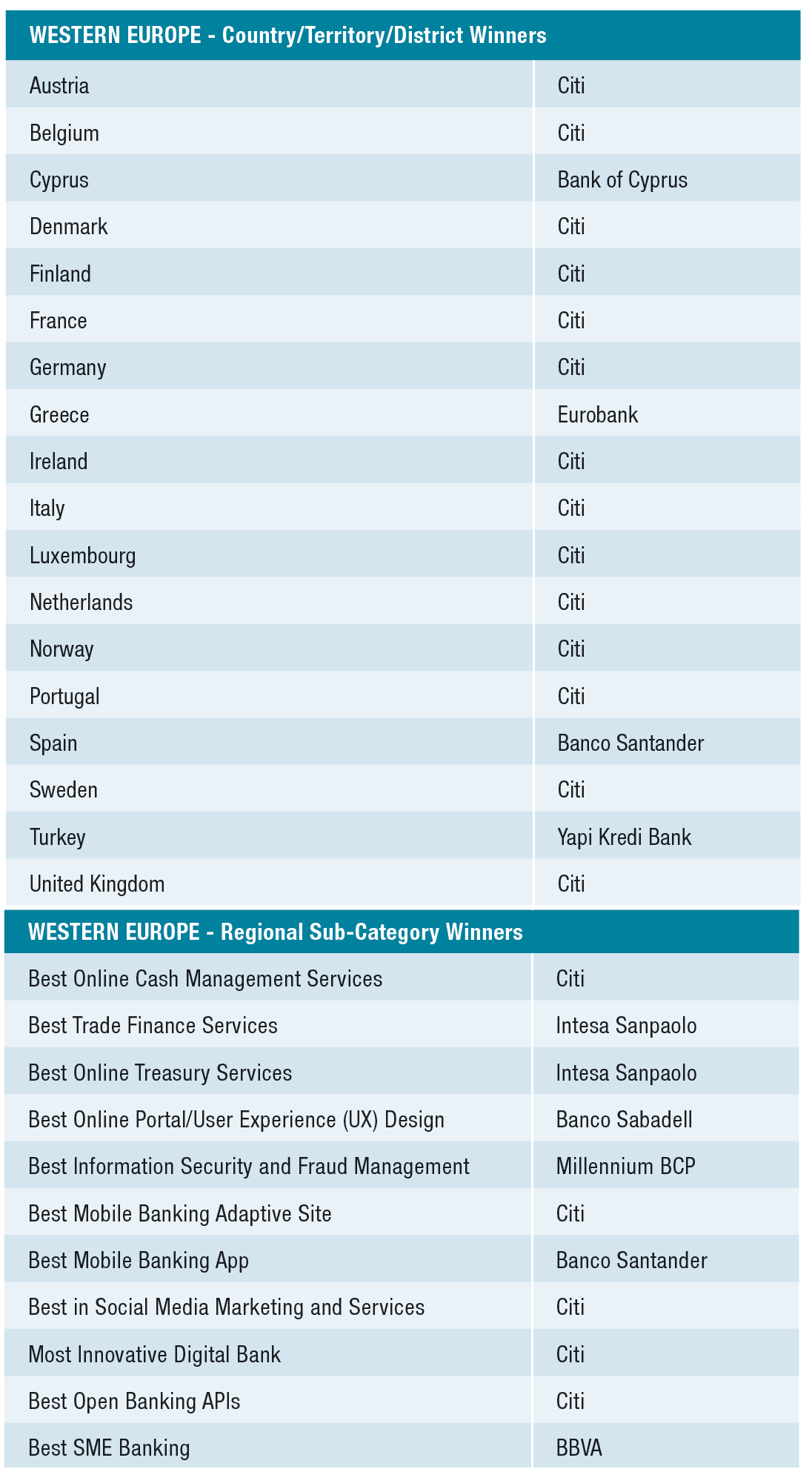Technology standards pay off big.

In 1999, Global Finance launched the world’s first internet banking awards to acknowledge the industry leaders that had begun introducing e-banking services and initiating banking’s digital revolution.
However, the lack of broad internet access meant early adopters were mainly tech-savvy males. Fast forward 23 years, and now 83.72% of the world’s population owns a smartphone, according to data provider Statista, and digital banking has become the norm.
Finding a bank that hasn’t launched an app, a chatbot and a full suite of application programming interfaces (APIs) is difficult today. Global Finance’s World’s Best Digital Banks awards are the ultimate accolade for banks that have turned to financial technology to bring greater flexibility to the banking industry.
Increased competition and demand for innovation continues to drive digital banking in ways few could have imagined at the start of the millennium, so we have continued to upgrade the awards to reflect the digitalization efforts banks continue to develop, either in-house or via third parties.
Open banking has opened pathways for banks to collaborate with other service providers, whereby banks share customer information through a secured API to provide an improved customer experience. Slovakia’s Tatra banka, the Best Mobile Banking Adaptive Site winner in Central and Eastern Europe (CEE), offers more than 15 partnerships established with fintechs, e-commerce platforms, invoicing and accounting software companies. China’s Ping An Bank, a three-time Asia-Pacific subcategory winner, integrated 1,046 merchants and released 819 products and 1,943 APIs on its open banking platform.
Citi, which won for Best Corporate/Institutional at the country and regional subcategory levels worldwide, is a strong proponent of APIs. “Today, APIs are the engine of the digital economy. From instant payments to open banking and digital assets like central bank digital currencies, APIs are transforming the financial market infrastructure,” notes Naveed Anwar, global head of Digital for Citi Treasury and Trade Solutions. “To help our clients achieve their digital goals, we need to think like a tech company versus a traditional bank, and that’s the model we are using at Citi. We are moving toward using modern standards, such as the OpenAPI 3.0 specification [which makes APIs easier to understand and use] and the JSON data-interchange format [which helps with sharing data between applications and servers], which will make our platforms easier for clients to access and use. As a result, we expect customer adoption to rise dramatically, especially with digital-native companies,” Anwar adds.
Citi Treasury & Trade Solutions deploys comprehensive solutions to help clients connect directly to the bank via APIs, allowing them to leverage the benefits of a rapidly evolving real-time digital ecosystem. “Our developer portal allows clients to access APIs across our payments, liquidity, cards and trade products. Citi has a rich set of digital solutions that enable growth for clients, and we are investing in our platforms to scale them for rapid growth,” says Anwar, describing them as digital doorways to its vast banking network, which covers more than 90 countries and is available in more than 25 languages. “When a treasurer comes to us, they are looking for a global digital solution to move more money between accounts for different entities across many countries. Companies do not want to work with multiple banks across multiple regions for a global solution. They are looking for a global platform with rich functionality, and we get that. We are actively investing to meet the evolving needs of digital natives as well as our traditional clients that are digitizing quickly,” Anwar says.
Personalizing the UX
Open banking and greater uptake of digital technologies ensured that user experience (UX) was a key area of bank innovation in 2021. Saudi National Bank (SNB), which made a clean sweep of Saudi Arabia’s awards, is committed to innovation and evolving its digital offering. SNB has tailored its distinctive UX and seamless journeys to fortify its digital transformation and supercharge digital uptake. “Customer experience has become the vital differentiating factor that distinguishes us from competitors, due to the similarity of digital products and services in the banking sector,” says Omar Yassine, senior executive vice president and Digital Banking head of SNB. “We highly value customer experience and have injected it into our DNA and placed it as ‘customer obsession.’ We have embedded it throughout the customer journey, in digitizing experiences and not just products that are fully customized and tailored based on a client’s segment, role, location, time, and even date and definitely device—giving clients what they need, at ease, at their very first steps with the right product offering,” Yassine says.
“Smart contextual experience and content—giving our clients the right message to the right user at the right time—was one of the major catalysts which gave us the inflection point we strived for in the overall digital penetration uptake,” Yassine continues. “More importantly, in the product and sales adoption over our digital channels, personalization resonates well with clients, given that most are persistently receiving cluttered and irrelevant campaigns. So, when a message that comes in meets their needs in an immediate and customized way, they are much more likely to take action.”
The Bank of Georgia, which won both the Corporate/Institutional and Consumer Banking regional subcategory awards for CEE, is also putting UX at the forefront of its innovation efforts. “Customer-centricity is key to everything we do,” says CEO Archil Gachechiladze.“We develop digital channels with our customers in mind, ensuring a simple and smooth user experience and embedding new products and features that fulfill a variety of customer needs.”
The bank collects customer feedback continuously and measures customer satisfaction to improve digital channels and make them more relevant in clients’ daily lives, he adds.“The agile delivery model lets us quickly turn feedback and ideas into the solutions our customers need. Our retail mobile app is the most popular financial mobile app in Georgia, with up to 1 million monthly active users and a high satisfaction score of 91%.”
“Corporate banking clients are increasingly hiring a new generation of treasury staff who have experienced some phenomenal digital innovation in their personal lives, from ordering cabs to purchasing groceries with just a few clicks on their mobile,” says Aphile Molefe, head of eFX Sales South Africa for Absa CIB, which won two Africa Corporate/Institutional awards. “Naturally, these increasingly tech-savvy clients are demanding the same seamless experience from the corporate bank that they work with,” he adds.
“Careful UX research, design and testing are required to achieve the appropriate ease of use for any platform,” Molefe says. “This is particularly so for corporate banking clients who naturally have more complex workflows due to the heightened risk and regulatory environment that they operate in. The ability to customize the platform is critical to cater to these infinitely diverse complexities of corporate workflows and the diverse users that have to navigate them.”
Personalization remains the holy grail of banking, but technology doesn’t stand still, and there is no room for complacency. In Capgemini’s Technovision: Financial Institutions 2022 report, the IT services and consulting company advises banks to invest in AI, machine learning and predictive analytics to meet personalization challenges.
TD Bank uses AI to anticipate customer needs, such as offering digital “nudges” based on their past behavior and transaction patterns. “A great customer experience is about meeting customer expectations and building trust via a human-centered design approach with personalization at its core,” says Imran Khan, head of Global Innovation for TD Bank Group. “At TD, we’re leveraging data and AI to help deliver highly connected experiences for our customers, with actionable insights tailored to their day-to-day banking needs.”
The need for digital convenience was turbocharged during the pandemic, providing a critical competitive advantage for banks. Today’s post-Covid customers expect the best digital experiences.
Methodology: Behind the Rankings
The Global Finance Best Digital Bank Awards winners are chosen based on entries provided by financial institutions. Entrants are judged on breadth of product offerings, success in migrating customers to digital platforms, acquiring and retaining new customers and using digital technologies to improve business processes, cut costs and deliver other benefits. Each entry is analyzed by a team of digital and banking experts at Infosys. All final selections are the responsibility of Global Finance.








